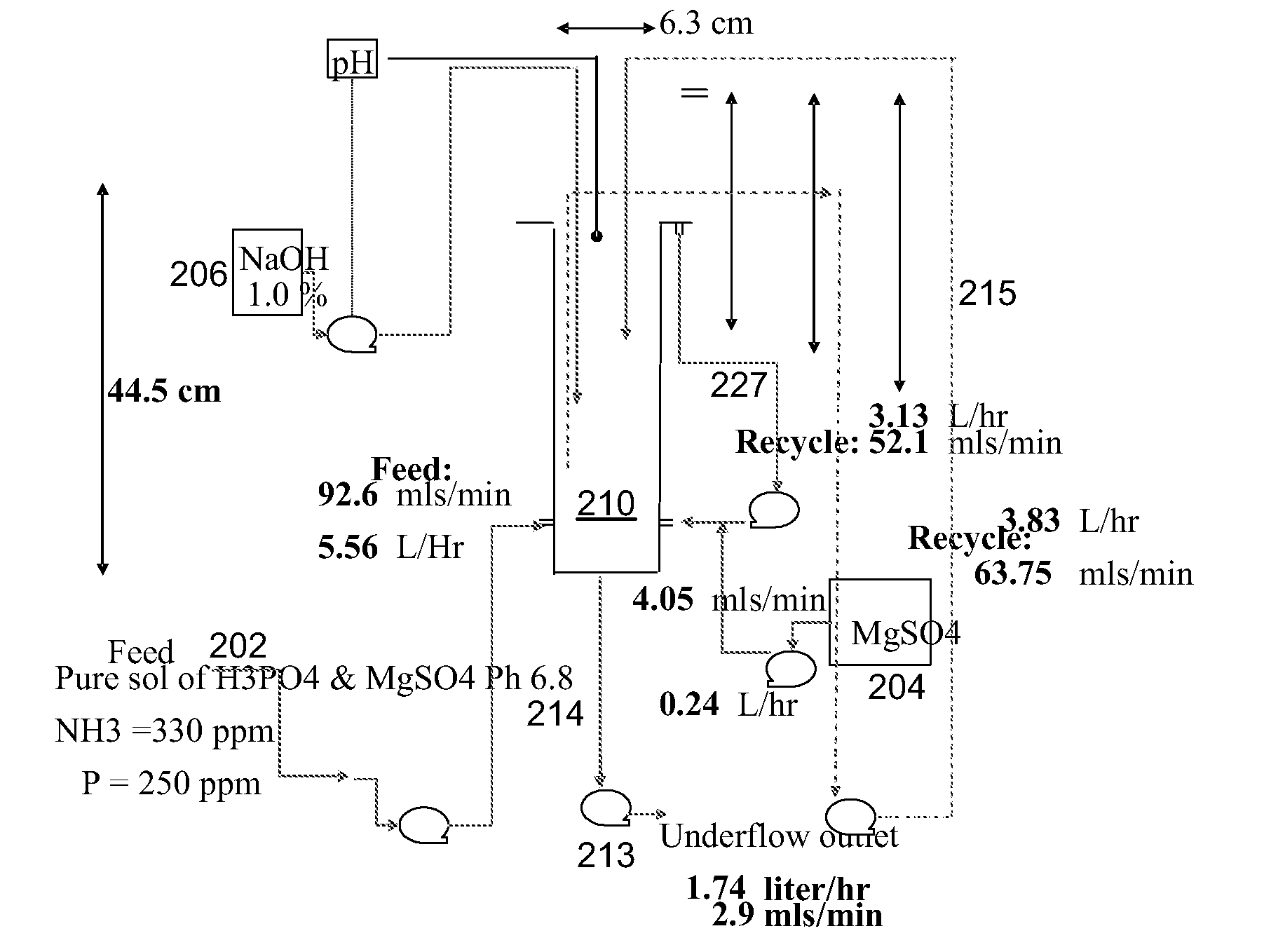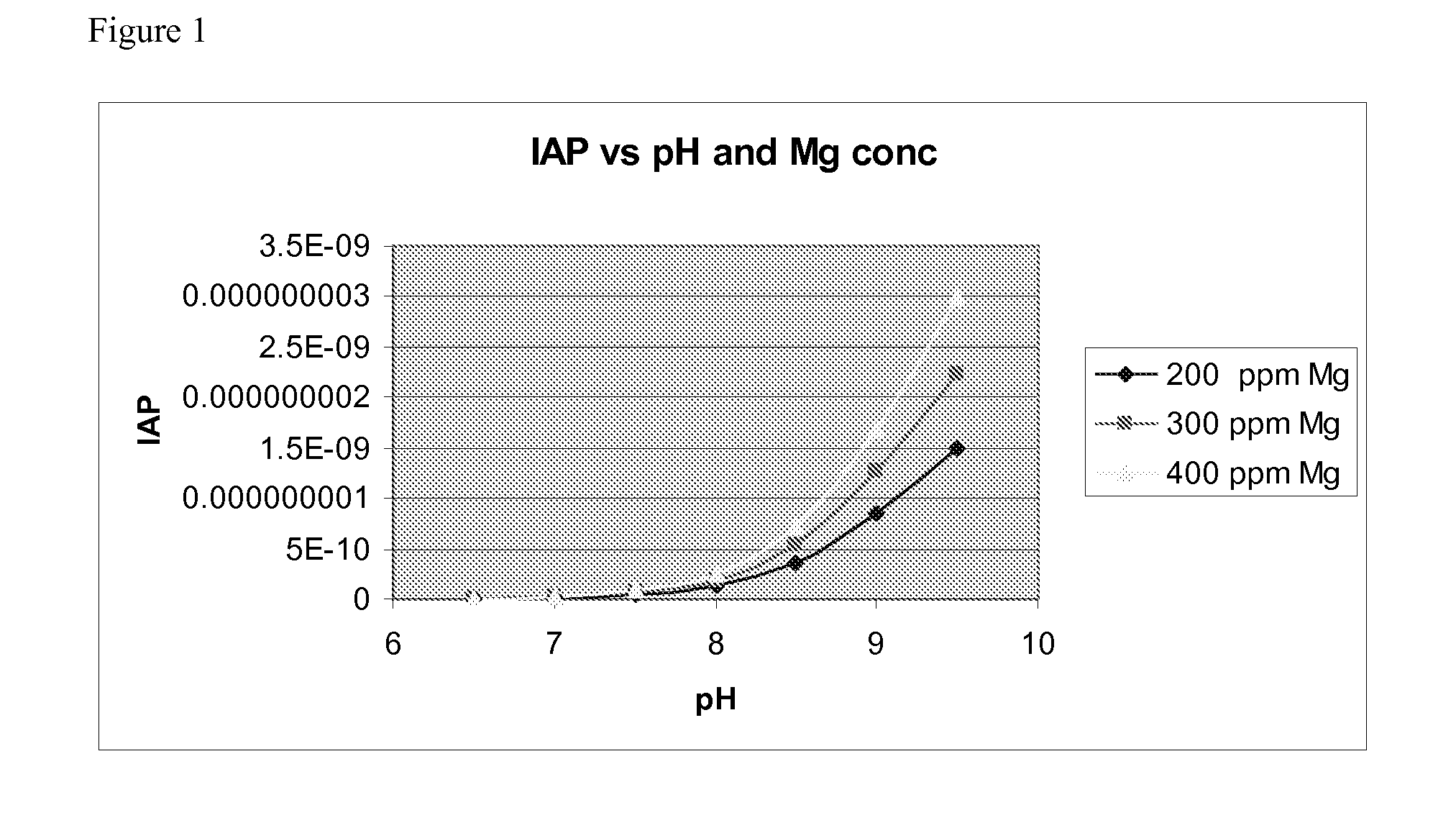System and Process for Removal of Phosphorous and Ammonia from Aqueous Streams
- Summary
- Abstract
- Description
- Claims
- Application Information
AI Technical Summary
Benefits of technology
Problems solved by technology
Method used
Image
Examples
example 1
Synthetic Waste Streams—4-Zone / 4-Vessel System
[0076]Background
[0077]In this example, a synthetic feed stream containing 500 ppm of NH4+ and 433 ppm of phosphorous was dosed with 590 ppm of Mg (added in the form of MgSO4). The experimental set up is shown in FIG. 2.
[0078]Methodology
[0079]The synthetic feed stream was fed into reactor 210 at its base. Concomitantly, the MgSO4 solution 204 and caustic base 206 were dosed into the same reaction zone to achieve maximum mixing of these three streams (see FIG. 3). The flow of caustic was controlled to meet a target pH of 7.7. A recycle loop 214, 213, 215 within reactor 210 was used to establish equilibrium in the series of reactors—once the whole system had reached steady state, this recycle loop could be diverted to a screen to capture 219 the struvite crystals formed.
[0080]Overflow from reactor 210 was allowed to pass to the second reactor 220, where the same reactor design enabled efficient mixing of this stream with more caustic 216—th...
example 2
Waste Streams from a Corn Refinery Waste Water Treatment Process—1 Vessel System
[0087]Background
[0088]In this example, the conditions required to achieve optimal phosphorous removal were established in one reaction vessel. The dimensions of the vessel 510 and the streams into and out of the vessel are shown in FIG. 5.
[0089]Experimental
[0090]The incoming stream 502 contains a molar excess of ammonium and phosphorous. To achieve the supersaturation conditions required to make struvite, it was necessary to supplement the amount of Mg ions in the reactor. This was done by feeding a stream 504 of MgCl2 under controlled conditions such that the excess Mg exiting in the final stream was minimized.
[0091]The pH profile across the reactor was established using two streams. One of these streams was caustic ion exchange waste (a medium-high pH waste stream from the corn refinery). This stream was mixed with the MgCl2 and injected into the reactor at a height of 25%. The other high pH stream was...
example 3
Waste Streams from a Corn Refinery Waste Water Treatment Process—2 Vessel System
[0095]The apparatus, consisting of two reactors (S1 and S2), was set up as shown in FIG. 7. Physical parameters of S1 and S2: diameter 6 in, height 12 in, volume 1.47 gal. A typical run was characterized by (S1) Hydraulic Residence Time (HRT) 9.1 min and velocity 2.00 m / hr and (S2) HRT 8.7 min and velocity 2.11 m / hr. Overflow 2 led to an optional filter, not shown.
[0096]The feed to S1 was the product stream from an anaerobic digester (27 L / hr, 0.3 wt % solids, 417 ppm P, 263 ppm NH3). This feed was mixed with a dilute NaOH (0.4% soln, 8.4 L / hr) stream in a mixing section in S1, along with a solution of MgCl2 (1.1 L / hr). The pH in S1 was 7.8-8. The underflow from S1 (spin test solids content=15%) was circulated at a rate of 33 L / hr, with 0.5 L / hr of struvite particles being drawn off. The struvite crystals are separated from the recycle stream by passing the whole through a screen.
[0097]The overflow strea...
PUM
| Property | Measurement | Unit |
|---|---|---|
| Speed | aaaaa | aaaaa |
| Speed | aaaaa | aaaaa |
| Speed | aaaaa | aaaaa |
Abstract
Description
Claims
Application Information
 Login to View More
Login to View More - R&D
- Intellectual Property
- Life Sciences
- Materials
- Tech Scout
- Unparalleled Data Quality
- Higher Quality Content
- 60% Fewer Hallucinations
Browse by: Latest US Patents, China's latest patents, Technical Efficacy Thesaurus, Application Domain, Technology Topic, Popular Technical Reports.
© 2025 PatSnap. All rights reserved.Legal|Privacy policy|Modern Slavery Act Transparency Statement|Sitemap|About US| Contact US: help@patsnap.com



